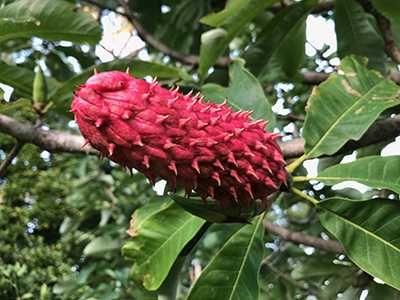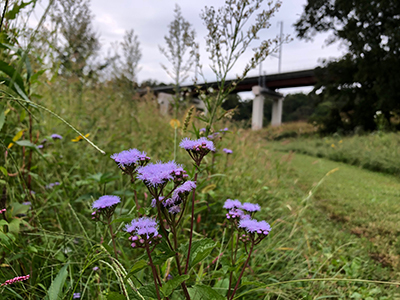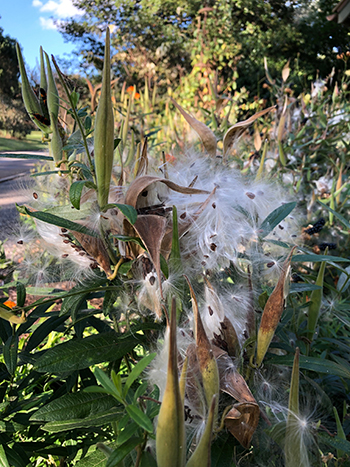
Plants of the Week – September 30

How do you mark the transition from summer to autumn in the garden? Is it the ripening of Cornus florida fruits? The transition of Ilex verticillata berries from green to red? The “plunk” of acorns dropping from above? One garden indicator for me is the coloring of Magnolia cones.
While not every species changes color, many do; including Magnolia grandiflora, southern magnolia, and M. officinalis, Houpu magnolia. Of the two, Magnolia officinalis is lesser known. A quick internet search reveals a majority of the information pertains to the potential medical benefits of the species. Native to the mountains and valleys of China, M. officinalis has long been used in traditional medicine. Flowers composed of creamy white tepals are produced in May-June. Perhaps even more stunning are the fuschia-red cones that begin to ripen in September. A specimen can be found in the Benjamin West parking lot. Photo credit: J. Coceano

The blue mistflower, Conoclinium coelestinum, is a vivid blue punctuation throughout the recently planted Crum Meadow planting. The herbaceous perennial, blooming from late summer through fall, is native to the eastern United States and often described as aggressive, a trait that serves it well as it competes with others for space in open, full sun settings. Spreading by rhizomes, blue mistflower is best suited for open areas and naturalized gardens. It can be added to the flower border so long as it has ample room to roam and won’t interfere with more reserved plantings. Photo credit: J. Coceano

As we humans continue to assert our influence on the environment, we often fail to realize the full extent to which it affects the flora and fauna that reside within. The beloved monarch butterfly is perhaps one of the best known species to illuminate our impact. As the population of monarchs drastically dropped, campaigns were launched to grow Asclepias tuberosa.
Commonly known as butterfly weed, Asclepias tuberosa is the larval host plant to monarch caterpillars and a popular nectar source for many other insects. We initially had trouble procuring A. tuberosa, perhaps due to its newfound popularity. Literature notes that A. tuberosa is best propagated from root cuttings or by seeds. Mature plants yield a bounty of seeds. Wait until seed pods naturally open to collect the seed. Remove the silky “parachutes” and sow the seeds allowing them to spend the winter outdoors. Seedlings emerge the following spring. Young plants often take one to two seasons before flowering occurs. Photo credit: J. Coceano





Alex M
Posted at 11:57h, 02 OctoberVery nice! Please keep up the good work!
Becky Robert
Posted at 12:14h, 02 OctoberThank you Alex. We are excited about the fall blooming plants now putting on a show.
Cheers,
Becky Robert
Scott Arboretum
Wendy C
Posted at 09:44h, 31 OctoberI am growing from seed and planting the swamp milkweed. So easy to grow and very successful with increasing our monarch population. It is a non aggressive plant here in southwest Nova Scotia. Enjoying your posts on fall blooms.